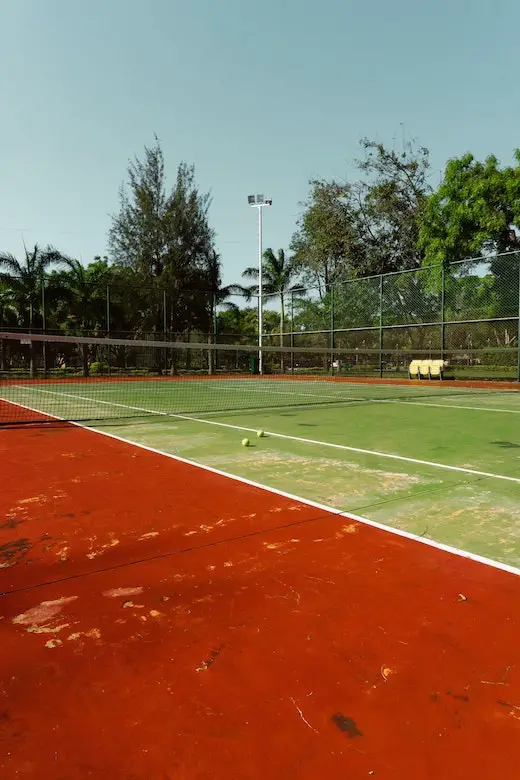- Perfect if you want to replicate/practice a particular shot
- Ideal if you struggle to find hitting partners
- Great if you don’t live near tennis courts
Your Guide
 Gavin Davison
Gavin Davison
Tennis rebounders aren’t necessarily something new, but not many people realize THE BENEFITS of actually investing in this piece of equipment.
It may seem a little quirky at first, with a strange-looking mesh and a white line to represent a net, but these cool little gadgets can be awesome for your game – especially for beginners.

Sure, once you reach the level of intermediate or advanced, tennis rebounders aren’t going to be the best things to practice with. But until you reach that point, they are WORTH LOOKING INTO.
As the name indicates, the objective for this piece of equipment is to keep the ball coming back to you – hence the ‘rebounder’ description.

You do need a fair bit of space if you are to use a tennis rebounder too, meaning that IDEALLY, you need a large garden or at least a quiet street where you can use it.
But if you do have access to these areas, and you are STILL LEARNING the game of tennis, you may want to keep reading!
You’ve already seen three reasons why a rebounder is a good choice above, but now, I’d like to get a little more specific on each element highlighted above (and more).
Situations in which you should consider getting a tennis rebounder
To clear up any doubts, a tennis rebounder is NOT SOMETHING I recommend for players who are intermediate or advanced.
That’s because you will likely be hitting the ball too hard to receive any real benefit here, and to be completely honest, you need real tennis to improve your game once you reach this level.
So, with that cleared up, let’s dive into the scenarios in which a rebounder is a good choice.
1)You Have a Certain Shot You Want to Practice
When learning the game, REPETITION IS EVERYTHING.
I guess it’s like anything really, the more you work at it, the more you’ll figure out what is working, what isn’t working, and what corrections you need to make to improve.
I’d like to place a FAIR BIT OF EMPHASIS on the word ‘repetition’ here, as THAT’S EXACTLY what you get with a tennis rebounder.
I remember my coach used to tell me that nobody beats the wall, and in this instance, nobody beats the rebounder!
Then again, that’s what you want, so that you get to hit plenty of balls and PRACTICE YOUR STROKES.
If you have the space, you can pretty much work on any shot you like here. But if space is of a bit of a premium for you, you can still work on shots like:
- Volleys,
- Slice groundstrokes,
- And even your serve.
2) You Want to Test Out Some Rackets
Testing a racket is extremely important before you decide to go and purchase one.
The worst thing you can do is to buy a racket before you have properly tried it.
And by properly, I mean that you have tested it several times to ensure that it is the right racket FOR YOU.
Basically, testing a racket is all about:
- How it feels in your hand
- How it feels when striking the ball
- Whether you like the sensation of the frame or not.
There are all kinds of tips out there for comprehensively testing a racket, but for the purpose of this piece, I won’t be running through those.
Instead, I will say that testing a racket requires HITTING PLENTY OF BALLS.
The more you hit, the more of an idea you will get as to whether you like that racket or not.
And what better way to hit plenty of balls than by picking a partner who never misses?
3) You Fancy a Workout Involving Tennis
Just because the tennis rebounder is designed to spring the ball back at you, this doesn’t mean that it can’t be a great tool FOR A WORKOUT.
Naturally, hitting plenty of balls will tire you out over time, but if you hit the ball at an angle with your rebounder, you will be MOVING and HITTING.
In a sense, this replicates the movement of SLIDING ACROSS the baseline and hitting forehands and backhands on a real court.
The only downside here is that you need to have plenty of space, although you could perform this side-to-side style of play by hitting volleys too.
And let’s be honest here, burning calories by hitting tennis balls is significantly more fun than slugging it out on the treadmill.
The fact that you can work on your strokes at the same time makes the PERFECT COMBINATION!
4) You Aren’t Getting Enough Court Time to Practice
This was always a problem for me as a kid. I lived near the tennis club, but I always STRUGGLED TO FIND players to practice with, and sometimes, the courts would just be booked out entirely.
This meant that I couldn’t get on the court and work on my game ANYWHERE NEAR as much as I would’ve liked.
But if I had a tool like a tennis rebounder as a kid, I could have put in HOURS OF MORE PRACTICE than I managed to do.
I’m sure my parents would’ve been thankful too, as this would’ve meant that I wasn’t hitting against the wall of the house anymore!
Even if the rebounder helps you to get an EXTRA HOUR or two each week, this can make an enormous difference concerning your progress, confidence, and ultimate enjoyment from the SPORT WE ALL LOVE.
My conclusion
It’s completely up to you whether you decide to purchase a tennis rebounder or not.
As I’ve stressed above, I wouldn’t recommend it if you are already relatively advanced with your game.
But if you are just starting out or there is a particular stroke that is frustrating you beyond belief, this is a WORTHWHILE INVESTMENT, in my honest opinion.
Have you used a tennis rebounder before? Do you have any product recommendations for us?
How did a rebounder help your game? Let us know in the comments.



